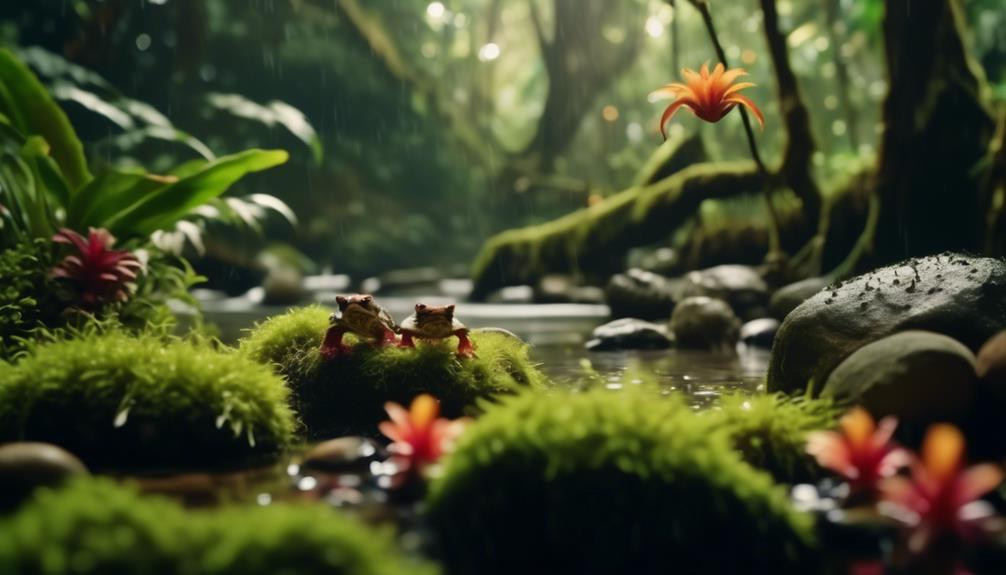
Have you ever wondered what lies beneath the vibrant shells of Central American Wood Turtles? These intriguing creatures hold a wealth of secrets waiting to be uncovered. From their unique physical characteristics to their captivating behaviors, there is much to explore in their fascinating world.
But what makes these turtles truly special is not just their outward appearance, but also the joy they bring when kept as pets. So, sit back and prepare to be amazed as we take you on a journey through the captivating world of Central American Wood Turtles, where surprises await at every turn.
Key Takeaways
- Central American Wood Turtles are small turtles with a lifespan of 30+ years and are relatively easy to care for.
- They are found in the wild habitats of northern Costa Rica to southern Nicaragua and are one of the subspecies of the Painted Wood Turtle.
- Adult turtles are about 8 inches long, with males having longer tails and being smaller than females. They have varying patterns on their shells, with Costa Rican turtles being more colorful.
- Central American Wood Turtles are sociable, well-tempered, and intelligent, and can be kept in a semi-terrestrial environment that mimics a marshy pond turtle habitat.
Size and Lifespan
Central American Wood Turtles are small in size and have a lifespan of 30+ years. These turtles typically reach about 8 inches in length when fully grown. Males are smaller than females and have longer tails.
The shells of Central American Wood Turtles have varying patterns, with Costa Rican turtles being more colorful. Some turtles even have yellow and orange swirls, black eyespots, and red or pink on their plastron. These turtles are sociable, well-tempered, and intelligent.
When it comes to their environment, Central American Wood Turtles are semi-terrestrial and can be kept outdoors in an 8×8 area or indoors in a tub or tank. They require a substrate of pea gravel, peat moss, dampened sand, and cypress mulch. It’s important to provide fresh, clean, filtered water and hiding spaces on land for them.
In terms of care requirements, Central American Wood Turtles have an omnivorous diet, which includes redworms, earthworms, crickets, and shredded vegetables and fruits. It’s recommended to dust their salad with a high-quality multi-vitamin and calcium supplement powder. Providing hiding places for their shy behavior is also important.
Captive-hatched turtles make better pets than wild-caught ones, and with proper care and handling, these turtles can become docile enough to be fed by hand.
Native Habitat and Species

The native habitat of Central American Wood Turtles encompasses wild habitats ranging from northern Costa Rica to southern Nicaragua. These turtles are one of four subspecies of the Painted Wood Turtle, and there are a total of eight Wood Turtle species in the Rhinoclemmys genus in Mexico and Central America. Adult Central American Wood Turtles are about 8 inches long, with males having longer tails and being smaller than females. They’ve varying patterns on their shells, with Costa Rican turtles being more colorful.
These sociable and well-tempered turtles can be found in semi-terrestrial environments, and their enclosures should mimic a marshy pond turtle environment, but slightly drier. Central American Wood Turtles can be kept outdoors in an 8×8 area or indoors in a tub or tank, with appropriate substrate and hiding spaces provided.
Physical Characteristics

As we shift our focus to the subtopic of ‘Physical Characteristics’, let’s now explore the notable attributes that define Central American Wood Turtles:
- Small in size: Adult turtles are about 8 inches long, making them a compact and manageable pet.
- Varying patterns on shells: Central American Wood Turtles have shells with unique patterns. Costa Rican turtles are particularly colorful.
- Sexual dimorphism: Males have longer tails and are smaller than females, allowing for easy identification.
- Distinctive features: Some turtles have yellow and orange swirls, black eyespots, and red or pink on their plastron, adding to their visual appeal.
These physical characteristics contribute to the overall charm and allure of Central American Wood Turtles. Their small size, unique shell patterns, sexual dimorphism, and distinctive features make them fascinating and visually appealing creatures to observe and care for.
Ideal Environment and Enclosure

To create an optimal living space for your Central American Wood Turtle, it’s important to consider the ideal environment and enclosure. These turtles are semi-terrestrial, so their enclosure should mimic a marshy pond turtle environment, but slightly drier.
You can keep them outdoors in an 8×8 area or indoors in a tub or tank. If you choose to keep them indoors, make sure to provide a substrate of pea gravel, peat moss, dampened sand, and cypress mulch.
Additionally, it’s essential to provide fresh, clean, filtered water and hiding spaces on land. Central American Wood Turtles are sociable and intelligent, so creating an enriching environment will help promote their overall well-being.
Remember to provide a balanced diet and proper care to ensure the health and happiness of your turtle.
Care Requirements and Diet

Creating an enriching environment for your Central American Wood Turtle goes hand in hand with ensuring their optimal care and providing a well-balanced diet. To meet their care requirements and maintain their health, consider the following:
- Diet: Offer a varied diet that includes pelleted commercial turtle food, fruits, vegetables, worms, and crickets. Dust their salad with a high-quality multi-vitamin and calcium supplement powder to ensure they receive all the necessary nutrients.
- Hiding Places: Provide hiding spaces in their enclosure to accommodate their shy behavior. These hiding places can be in the form of rocks, logs, or plants.
- Captive-Hatched Turtles: Opt for captive-hatched turtles over wild-caught ones. Captive-hatched turtles are generally healthier and adapt better to captive environments.
- Handling: Proper care and handling can make turtles docile enough to be fed by hand. This allows for a more interactive and rewarding experience with your turtle.
Choosing the Right Pet Turtle

When selecting a pet turtle, it’s important to consider various factors to ensure that you choose the right one for your specific needs and preferences.
First, think about the size of the turtle. Central American Wood Turtles are small, measuring around 8 inches in length.
Next, consider the lifespan of the turtle, which is 30+ years.
Additionally, think about the level of care required. Central American Wood Turtles have a low difficulty of care, making them suitable for beginners.
If you’re looking for similar breeds, you can consider the Brown Wood Turtle or the Black Wood Turtle.
Lastly, consider the diet of the turtle, which includes a variety of foods such as pelleted commercial diet, fruits, vegetables, worms, and crickets.
Frequently Asked Questions
What Are Some Common Health Issues That Central American Wood Turtles May Experience?
Some common health issues that Central American Wood Turtles may experience include respiratory infections, shell rot, and parasites. Regular veterinary check-ups, proper hygiene, and a balanced diet are important for their overall well-being.
Can Central American Wood Turtles Be Kept in a Tank With Other Turtle Species?
No, central American wood turtles cannot be kept in a tank with other turtle species. It’s best to house them alone to ensure their safety and well-being.
Are Central American Wood Turtles Prone to Escaping From Their Enclosures?
Yes, Central American Wood Turtles are prone to escaping from their enclosures. Ensure a secure enclosure with a lid or fencing that they can’t climb or dig under to prevent escapes.
How Often Should Central American Wood Turtles Be Fed and How Much Food Should They Eat?
You should feed your Central American Wood Turtle every other day, offering them a variety of food like worms, crickets, and shredded veggies. They should eat an amount that is about the size of their head.
What Is the Average Cost of Purchasing a Central American Wood Turtle and What Are the Ongoing Expenses for Their Care?
The average cost of purchasing a Central American Wood Turtle varies, but ongoing expenses for their care include food, enclosure maintenance, and veterinary check-ups. It’s important to budget for these expenses to ensure the well-being of your pet.
Are Cagles Map Turtles Related to Central American Wood Turtles?
The fascinating Cagles map turtle discovery has revealed that they are not related to Central American wood turtles. Despite their similar appearance, genetic studies have shown that these two turtle species are not closely related. This discovery has provided new insights into the evolutionary history of these fascinating reptiles.
Conclusion
Now that you have explored the world of Central American Wood Turtles, you can see why they make such captivating pets. With their long lifespan, sociable nature, and easy care requirements, these turtles are a joy to have in your life.
Whether you choose to keep them indoors or outdoors, you can create the perfect environment for them to thrive.
So, why wait? Start your journey with these remarkable reptiles and experience the joy of sharing your life with Central American Wood Turtles.




